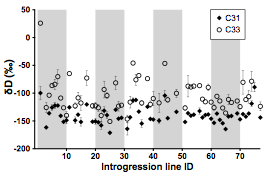Reports: DNI253417-DNI2: Deconvolution of Sources of Isotopic Variability in Higher Plant Biomarkers
Alexander S. Bradley, Washington University in St. Louis
A valuable set of analytical techniques in organic geochemistry relates to the measurement of the isotopic composition of individual hydrocarbons. Plant waxes are one potential source of hydrocarbons, and are largely comprised of long-chain (>C22) alkanes, fatty acids, and alcohols deriving from a variety of terrestrial sources. During Year 1 (2013-2014), we worked to characterize the underlying biological variability of isotopic compositions of plant wax hydrocarbons from plants grown under a relatively controlled set of conditions. In Year 2, we focused on a set of experiments designed to better deconvolute the sources of isotopic variability in plants by quantifying the amount of variability that can be attributed to genetic vs. physiological factors.
In this approach, we examined the isotopic variability among introgression lines of two closely related species: cultivated tomato (Solanum pennellii) and wild tomato (Solanum lycopersicum). These species are ideally suited to the study of wax variability, because they are adapted to extremely different hydrological regimes. S. pennellii is highly adapted to water-replete conditions, having been cultivated by humans under irrigated conditions for several thousand years. S. pennellii is native to the Atacama desert in Peru, and is highly adapted to intense drought. For these reasons, tomato has been a model in the study of the underlying mechanisms of how plants become more drought tolerant. Because leaf waxes are thought to play a role in plant water conservation, these plants make an ideal target for studying biological sources of plant wax structure and isotope variability.
In Year 1 we conducted a greenhouse study in which we grew both S. pennellii and S. lycopersicum under identical water-replete conditions. In addition to these two organisms, we grew 76 introgression lines (ILs) in which sections of the genome of S. lycopersicum have been inserted into S. pennellii. Among the 76 lines, the entire genome of S. lycopersicum is represented in the S. pennellii background. Each IL was grown in quadruplicate, and we continuously monitored temperature, relative humidity, PCO2, and the 13C content of CO2 in the greenhouse. ILs were grown in quadruplicate.
In Year 2, we conducted a field study in which we grew each introgression line at a replication of 15. We have analyzed the deuterium/hydrogen ratio of lipids from all ILs at a replication of four. Further characterizations involve structural characterizations of the degree of methylation of leaf wax lipids, and the average chain length. These metrics are being combined with analyses completed by collaborators characterizing the phenotypic variations in leaf shape, root morphology, and leaf metallomes in these introgression lines.
In Year 3 we continued analysis of the field study and are preparing the results for publication. We performed additional experiments examining the variation of the isotopic composition of leaf wax lipids using the same tomato species grown in growth chambers.
| Figure 1: variation of dD of C31 and C33 alkanes by Introgression Line ID |


We are primarily interested in quantifying the degree to which variation in plant-related phenotypes that are used as paleoclimate proxies (_13C, _D, average chain length) can be ascribed to genetic (biological) versus environmental variation. Geochemists commonly use these metrics in a purely climatological sense, and implicitly assume that the variability attributable to biology is near zero. In order to quantify this implicty assumption we have used characterizations of broad-sense heritability (H2)
which is the proportion of the phenotypic variance that can be attributed to the sum of all genetic contributions to the phenotypic variance (i.e. excluding the phenotypic variance that can be attributed to environmental factors). A broad sense heritability of greater than 0.6 is considered very high, while values of H2 over 0.4 are high, and between 0.2 and 0.4 are intermediate. H2 values of less than 0.2 are considered low, and reflect traits where variance is mainly driven by non-genetic factors (such as environmental variation).
Our preliminary results suggest that attributes of leaf waxes have relatively low heritabilites. While some traits such as carbon preference index (CPI, H2 = 0.47) are highly heritable, other traits have low heritabilities. Average Chain Length (ACL) shows some variability among our introgression lines with a heritability of only 0.1, while δD of n-C31 and n-C33 alkanes have heritabilities less than 0.5.
Broadly speaking, this is an encouraging result with regard to the applicability of alkanes as recorders of paleoclimate variability, as they suggest that at least in this group of organisms, genetic factors do not strongly encode the variations in leaf wax metrics that might be observed in sediments. In contrast, these proxies are only weakly heritable, leaving open the possibility that environmental parameters such as hydrological regime and average growth temperature play a strong modulating role in encoding them.
| Figure 2: variation of heritability values (H2) for several leaf wax metrics and for two leaf morphology metrics (morphology scores from Chitwood et al., 2013 Plant Cell) |













